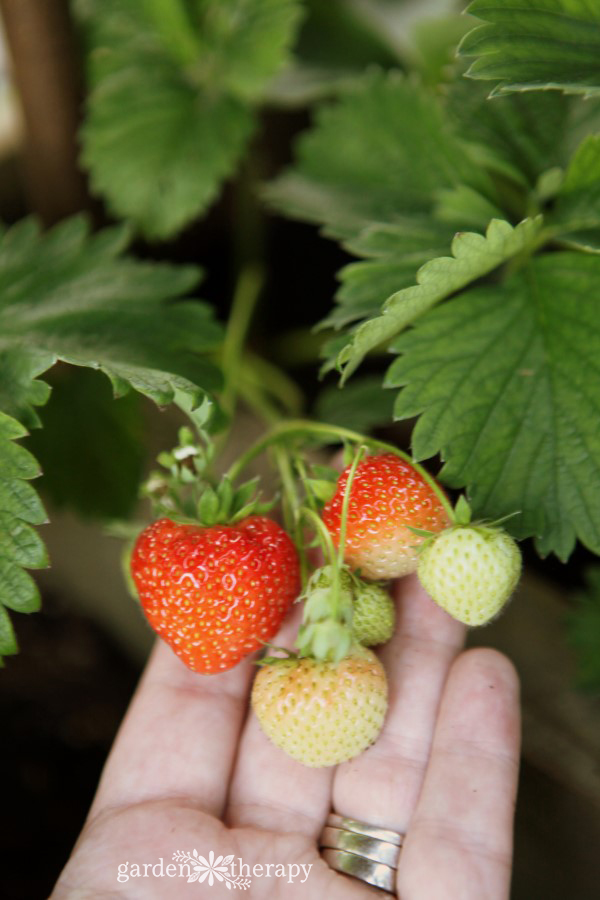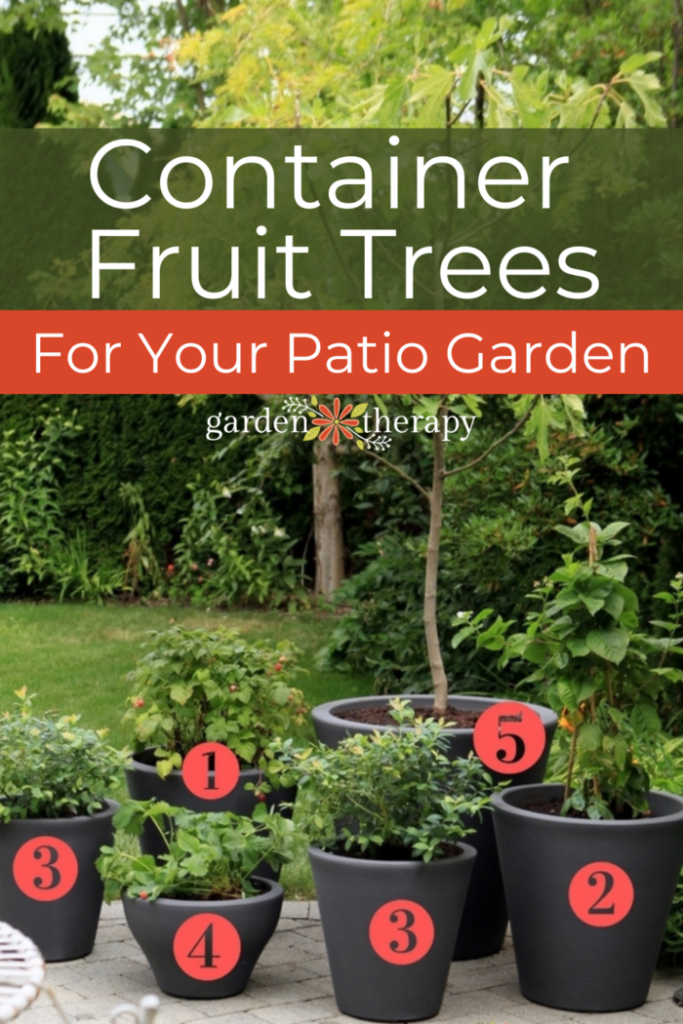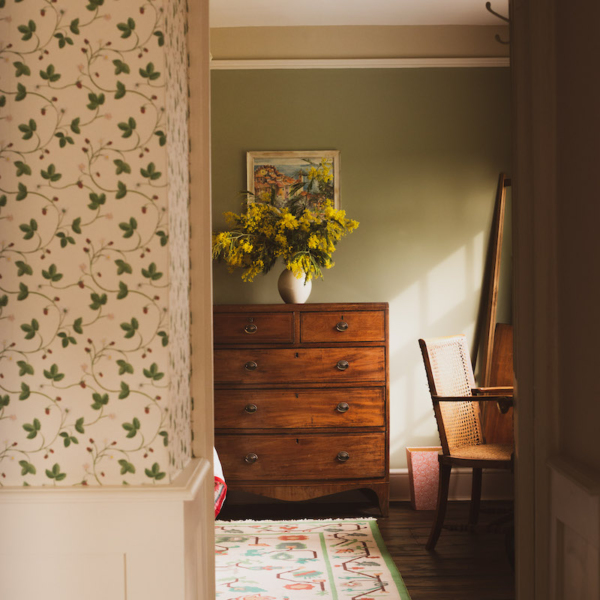Raspberries, blackberries, blueberries, strawberries, and even container fruit trees can sweeten up a small space. With these pretty plants and stylish containers, you can have a patio fruit garden that’s not only yummy, but decorative too.

If you think of garden-grown fruit as tasty treats from less-than-sweet-looking thorny vines or gnarled trees, you are in for a surprise!
Some exciting new fruit plants have been developed that match aesthetics with function, which means you can get luscious fruit from a plant that’s as gorgeous as it is useful.
Just imagine waking up and plucking some fresh blueberries to put on your morning yogurt. Sounds absolutely dreamy!
I love growing container fruit trees and bushes, as they allow just about anyone to access to fresh fruit. They work wonderfully for small urban gardens and apartments with balconies.
I talk a lot about food forests and permaculture zones, and planting these small-scale fruiting plants makes these concepts much more accessible to gardens. It’s all about adapting to your own garden.
This post will cover…
Plan Your Patio Fruit Garden
Before you pick your fruit, pick the space to grow it in. Fruit plants produce best in full sun, so choose a location that gets bright light for at least six to eight hours per day. These plants are so pretty, you will want them to be center stage.
As patio fruits are large perennial plants, shrubs, and trees, select containers for the long term. The containers I used for my patio fruit garden were provided by Crescent Garden. They are made of weatherproof plastic and have double-wall construction to insulate the soil from extreme cold or heat.
They’re pretty hardy and have a 10-year warranty, making them perfect for perennial fruit plants that will last throughout many growing seasons.
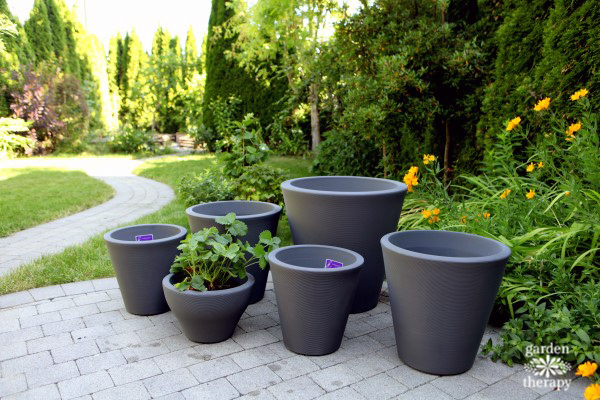
When choosing large containers for perennial fruit, be sure they have ample drainage holes, especially if you live in a rainy climate. Before planting, lay a piece of landscape fabric over the drainage holes to prevent soil from coming through and staining the patio / clogging the hole.
If you are setting the containers in a garden directly on the soil, raise up the containers on bricks to ensure the drainage hole is free-flowing.

When growing food, you want to keep the plants as close to the home as possible. This makes the food more accessible and top of mind for when you want to harvest it, but it also makes maintenance easier as you’ll likely be checking them daily.
This layout comes from permaculture zones, where your most cultivated space is just steps away from your door, followed by your food forest.
Container Fruit Trees and Bushes
It is wonderful to have edible plants that do double duty in the garden, especially when you have a small space. For this project, I chose each variety of fruit plants for both prolific potted fruit trees and attractive plants.
All of the plants in this patio fruit garden are self-pollinating, meaning they don’t need a partner to produce fruit. Even so, you may want more than one of each once you taste the fruit!
More often than not, fruit trees are going to be more prolific if there are two of them for pollination, even those that self-pollinate.
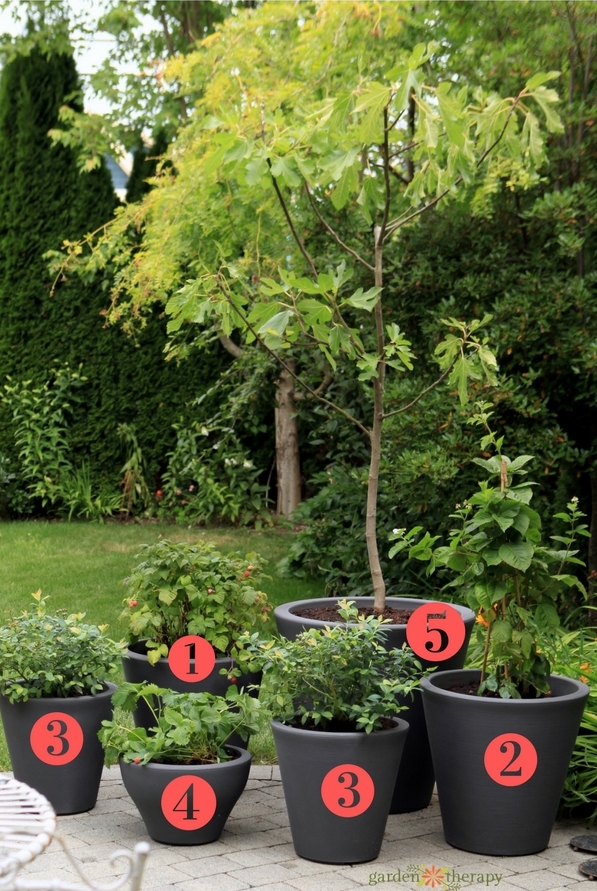
Here are the potted fruit trees and shrubs I decided to grow in my patio garden:
- Raspberry Shortcake® Raspberry shown in a 20″ Madison pot in slate
- Baby Cakes™ Blackberry shown in a 20″ Madison pot in slate
- Pink Icing™ Blueberry shown in two 16″ Madison pots in slate
- Seascape Strawberry shown in a 16″ Juno pot in slate
- Corky’s Honey Delight® Fig shown in a 26″ Madison pot in slate
Patio Raspberries
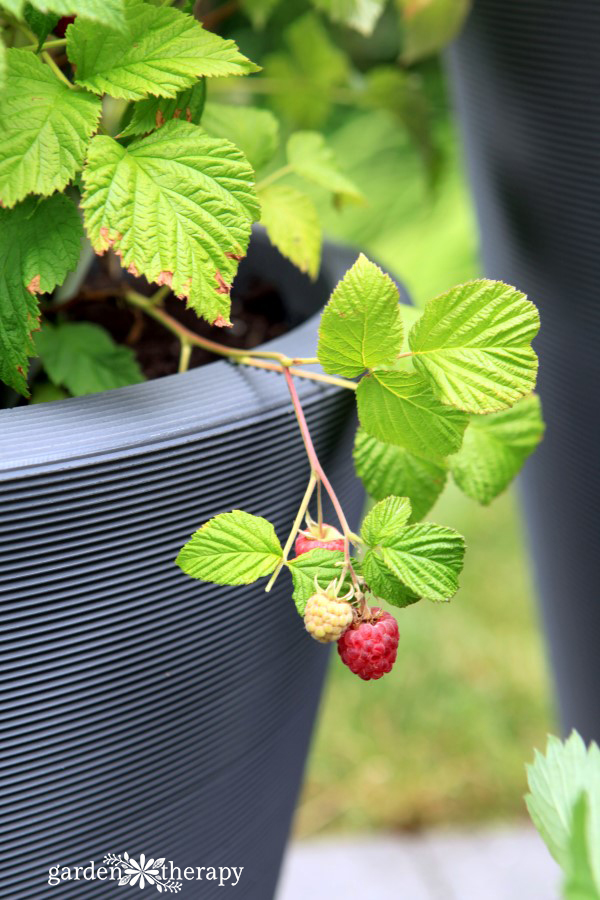
Variety: Raspberry Shortcake® Raspberry
Why it’s awesome: This compact and tidy shrub raspberry revolutionizes raspberry growing for the home garden. No longer will you have to put up with unwieldy brambles of thorns taking over your garden so that you can harvest buckets of raspberries in the summer.
Raspberry Shortcake needs no staking and grows well in a container. Even more, it produces a ton of berries! I have two plants in their second year, and I can’t keep up with all the berries, even with a fruit-loving Kiddo in the garden.
Zone: 4-9
Container size: Large (24-36”)
Special needs: Raspberry Shortcake can overwinter right in the garden, especially with a large double-walled container. In very cold climates, you can move the container undercover or to an unheated garage, keeping the soil just slightly moist.
Pruning and maintenance: Fruit will grow on second-year wood, so let the new shoots grow undisturbed in the first and second years. In early spring, prune all of the dead canes right back to the soil, and leave anything else that has new growth on it. You can shape the old canes by trimming their tops to form a rounded shrub.
Patio Blackberries
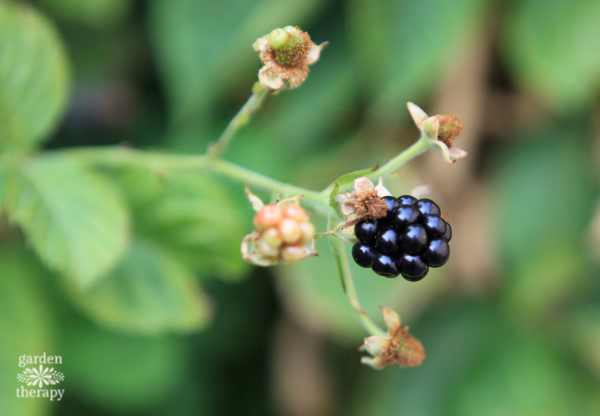
Variety: Baby Cakes™ Blackberry
Why it’s awesome: This three-to-four-foot tall set of vines produces not one but TWO sets of large fruit in the season. Oh, and there are no thorns, so you will save your arms from those itchy scratches while snacking on the sweet, sweet berries.
Zone: 4-8
Container size: Large (24-36”)
Special needs: Baby Cakes needs some staking to keep the branches from flopping over. Build a bamboo support with three poles tied together at the top, use a decorative obelisk, or tie the branches to a trellis. An upside-down tomato cage also works well!
Pruning and maintenance: Fruit will grow on second-year wood, so let the new shoots grow undisturbed in the first and second years. In early spring, prune all of the dead canes right back to the soil and provide support for the new growth.
Patio Blueberries
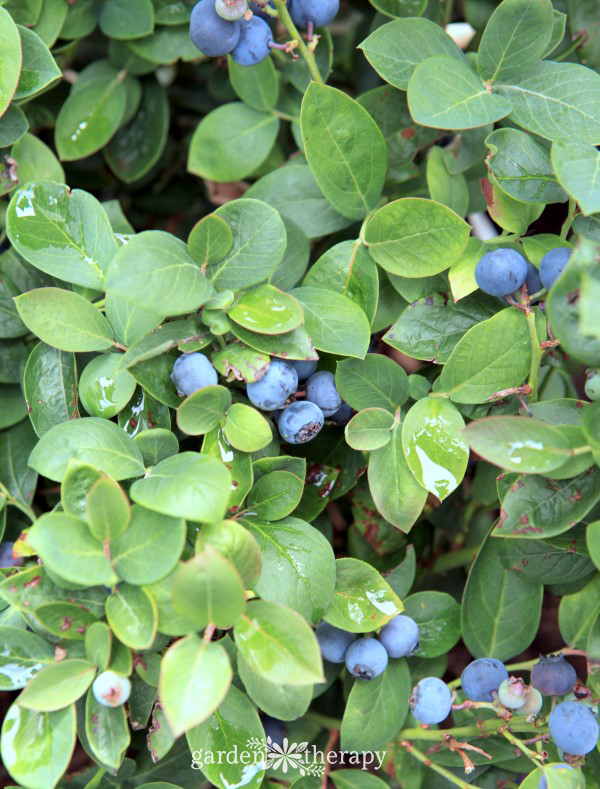
Variety: Pink Icing™ Blueberry
Why it’s awesome: This plant not only produces big juicy blueberries, but it’s also a four-season stunner! The name “pink icing” comes from the delicate pink tips highlighting the new foliage. The foliage itself is a dusty blue-green that perfectly complements the pink. In the winter, the foliage hangs on and turns an iridescent turquoise blue. Pink Icing is certainly the belle of the ball!
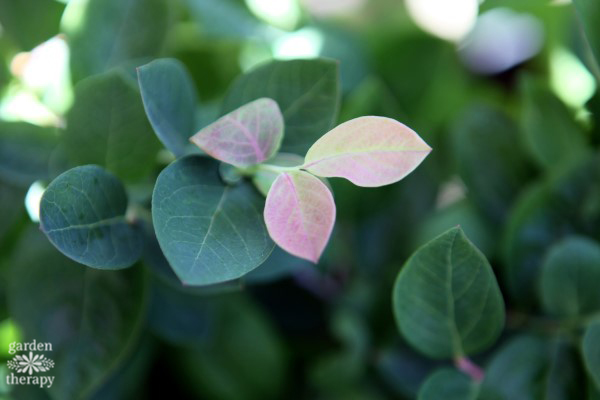
Zone: 5-10
Container size: Medium (16-24”)
Special needs: Blueberries like acidic soil with a pH balance of 4.5 – 5.5, so you may want to add some peat moss to the soil mix to increase the acidity if your soil is neutral.
Pruning and maintenance: It’s best to prune blueberries in early spring when the plants are still dormant. Blueberries fruit on 2, 3, and 4-year-old wood, so be sure to remove any dead wood or non-fruiting wood to allow the plant to put energy into maximizing fruit production.
For more tips on growing blueberries, read my full blueberry guide.
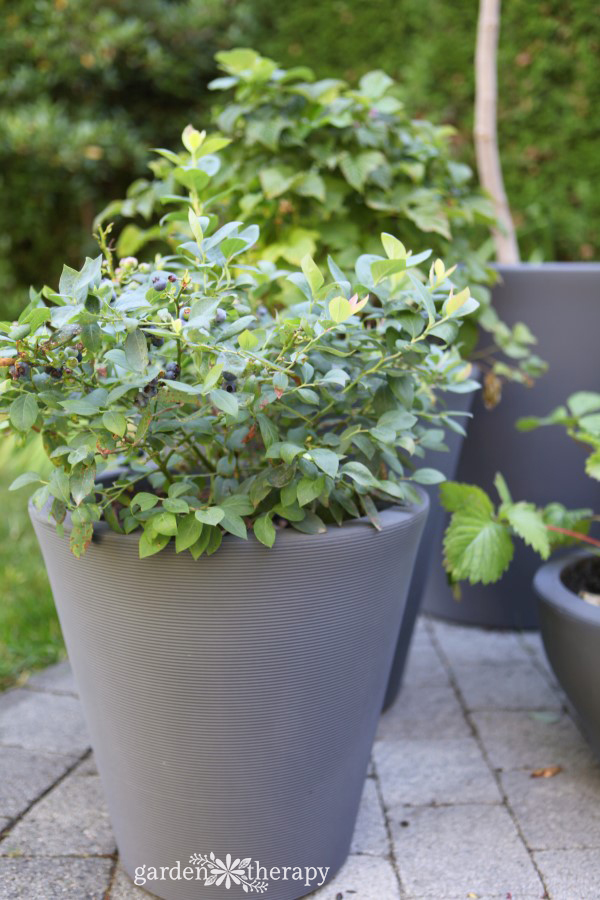
Patio Fig Tree
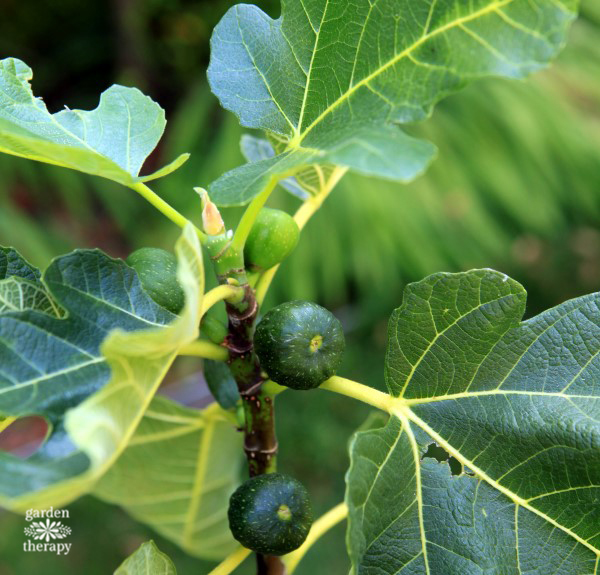
Variety: Corky’s Honey Delight® Fig
Why it’s awesome: There is really nothing like the flavour of a fresh fig, and this semi-dwarf cultivar means that you can have them twice in the season! Corky’s Honey Delight is known for its vigorous habit and bountiful amber-coloured fruit. The leaves are glossy green and quite attractive, even when the fruit has been gobbled up.
Zone: 7-10 (but often hardy and prolific in zones 5 and 6 as well, if planted in a sheltered location)
Container size: Extra large (30-36”)
Special needs: In colder areas, move the container undercover or to an unheated garage, keeping the soil just slightly moist for the winter months.
Pruning and maintenance: To keep the size manageable in a pot, shape them in the dormant season by removing any of the 4Ds. Then, cut back any leggy branches. In mid-summer, crop the branches back, leaving just five or six leaves. In the fall, remove any large fruit that didn’t ripen.
Find more tips on growing fig trees here.
Strawberries
Variety: Seascape Strawberry
Why it’s awesome: This ever-bearing strawberry is highly productive over a long season, yielding large berries with excellent flavour. It produces well in a wide range of climates and should yield fruit for up to ten years.
Zone: 4-9
Container size: Small (10-16”)
Special needs: None!
Pruning and maintenance: Read about growing strawberries in containers here.
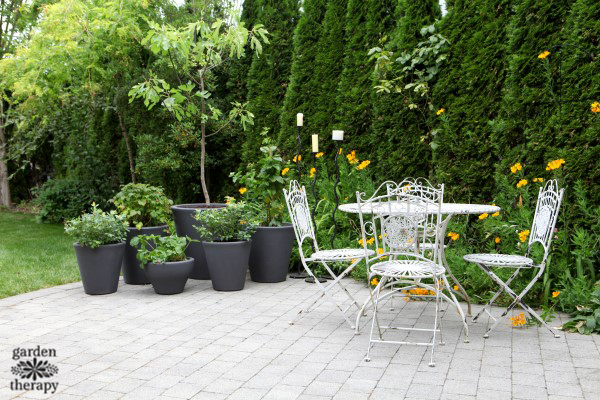
More Container Fruit Trees
Besides what I’ve grown here, there are more fruit trees that can grow in pots. The key is to look for varieties that are either described as dwarf or compact. You don’t want anything that naturally grows very large or won’t be happy in a container.
Here are some more plants you can grow as fruit trees in pots, depending on where you live:
For more ideas for container fruit trees and other edible plants, check out these unique edible fruit plants or these container food garden ideas.
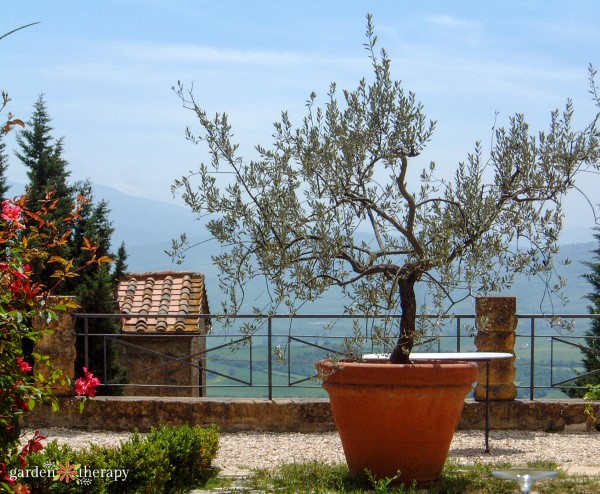
Frequently Asked Questions About Growing Fruit Trees in Pots
Absolutely! They will require more care than those planted in the ground, however. Container fruit trees tend to dry out faster and may need daily watering when it’s really hot out. It’s also advisable to prune them during the dormant season to keep their size manageable.
It depends on the type of fruit tree you grow, but they can live as long as their in-ground counterparts when properly cared for. Also, ensure the type of fruit tree is suitable for living in a container. Otherwise, they will have a shorter lifespan.
When looking for fruit trees, you can’t just plant any that you find at the garden centre. You need to plant dwarf varieties or plants described as compact or with a shallow root system. These will all be fruit trees that can grow in pots and succeed.
Ideally, you want to give them cover or move them inside to a garage or shed. The soil should be kept just slightly moist. Their growth should also slow down, so they won’t need a ton of light either.
If you have the space, you can bring them indoors. You want to place the plants away from any heaters or drafts and as close to bright light as possible.
Better yet, if you have a cold greenhouse, you can overwinter many different types of potted fruit trees.
More Ways to Grow Food in Containers
